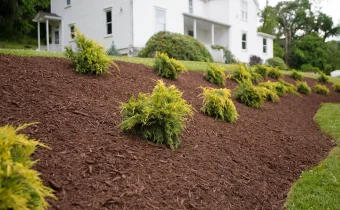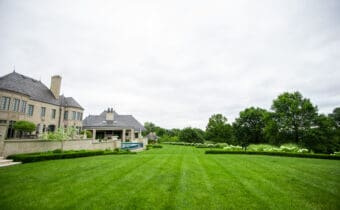If we were to ask for your secrets to healthy living you might point to diet, exercise and rest or sleep.
While there are countless other variables, such as vitamin supplements or spending quality time with family and friends, diet, exercise and rest are the basics that most of us try to keep in balance.
The same is true for your landscape plants.
Many influences collectively keep them healthy, but it turns out you only need to keep air and water in check because plants make food using the photosynthesis process.
Contrary to what many people think, fertilizer is not plant food but a supplement for achieving desirable ornamental plant qualities, such as vivid flower and leaf color.
It gets even better.
Water and air naturally strike their own balance, so if you help your plants by becoming familiar with these watering tips, everything else should fall into place to keep your plants healthy.
#1. Practice Water Supply Timing
In our previous article: What Every Homeowner Needs to Know about Lawn and Landscaping Soils we discussed why ornamental landscape plants need plenty of air and water to thrive, but not too much of either one because that leads to a shortage of the other.
Pittsburgh Soil Conditions
Our Pittsburgh soils can be classified as predominantly clay. That composition is good for storing water, but if the soil does not also contain sufficient organic matter to ensure proper drainage, it’s possible for it to become completely waterlogged, thereby squeezing out necessary air.
If you know this to be true please contact our offices and we can make some recommendations for amending and rebuilding your soils.
Moisture Storage
In addition to soils, moisture is also stored in plant cells. You can correctly assume that larger trees and shrubs have a greater capacity for storing water. Not only that, mature plants tend to have predictably stable water requirements.
Therefore, periodic deep watering is the recommended practice to supplement what Nature provides.
In contrast, young annual flowers will need to be watered much more frequently during the growing season because they are growing rapidly and do not have dense, fibrous stems for storing moisture. For this reason, they should be regularly monitored.
Watering Time
If you happen to notice wilting of young plants during hot, windy summer days, time is of the essence. You may only have a few hours to hydrate them before the cell walls collapse. If that happens there is no way for water to reenter and they will unfortunately die.
Obviously, you have more time with woody plants, especially evergreens that have a waxy surface that keeps the moisture from evaporating so quickly on hot days.
If you are in doubt about whether or not to water your plants, it’s always smart to use a time-tested procedure: Poke your hand into the soil to check the level of moisture.
Also, refer back to our mulching tips because proper soil cultivation and mulching will greatly minimize harsh soil temperature fluctuations and moisture loss.
#2. Balance Automated and Manual Watering
The rule of thumb is to practice deep watering because this gives plants the moisture they need today while also storing a little extra for the future.
 This is why you should not rely 100% on automatic irrigation systems. Instead, supplement them with manual watering as necessary providing extra water when and where it’s needed.
This is why you should not rely 100% on automatic irrigation systems. Instead, supplement them with manual watering as necessary providing extra water when and where it’s needed.
Most important is that your personal involvement allows you to inspect your plants for potential problems like animal damage or plant diseases.
Additionally, if conditions are especially hot or windy a good portion of that irrigated water may quickly evaporate or run off before it can soak the soil. Again, you have to monitor and take action, which should include calling our offices if you are in doubt.
#3. Address Special Seasonal Conditions
Be Mindful of Rain
 One special watering situation that you should be aware of is the benefit of natural rain. Electrical storms charge the atmosphere with nitrogen that rain brings to your plants. This is why your lawn sometimes gets emerald green after a thunderstorm.
One special watering situation that you should be aware of is the benefit of natural rain. Electrical storms charge the atmosphere with nitrogen that rain brings to your plants. This is why your lawn sometimes gets emerald green after a thunderstorm.
It’s not your imagination. So, be sure you turn off or pause all automatic irrigation systems to take advantage of this free fertilization effect because irrigating during or soon after a natural rain event dilutes or washes most of it away.
Hydrate Early
Another special water consideration is ensuring that woody plants are sufficiently hydrated before they enter the winter season. One reason for this disciplined late fall watering of tree and shrubs is giving them the opportunity to take in moisture before they go dormant.

Equally important is moisturizing the soil. The reason for this is that subzero temperatures can burn tree and shrub roots if they are not properly hydrated. If the soil is mostly water it will freeze, remaining at 32 degrees Fahrenheit.
However, soil that is dry and airy will drop to as low as the air temperatures go. This results in freeze-drying or burning of root systems.
Plants growing on slopes or in planters are more susceptible to this because their roots have greater exposure to drying winds and temperatures. Give them special attention and do the same for evergreens that are actively releasing moisture to the atmosphere but taking little in.
Brand New Plants
Finally, here’s a practice to remember if you have freshly planted annual flowers, perennials, or trees and shrubs that encounter excessive wind and or heat soon after planting. The first measure to take is cooling down the foliage (known as syringing) with a direct mist of water for a few minutes. After that water the roots as you normally would.
You probably didn’t realize that there was so much to know about watering your landscape plants, but we hope that by organizing everything into three categories will help you have the most vibrant landscaping in the neighborhood!



